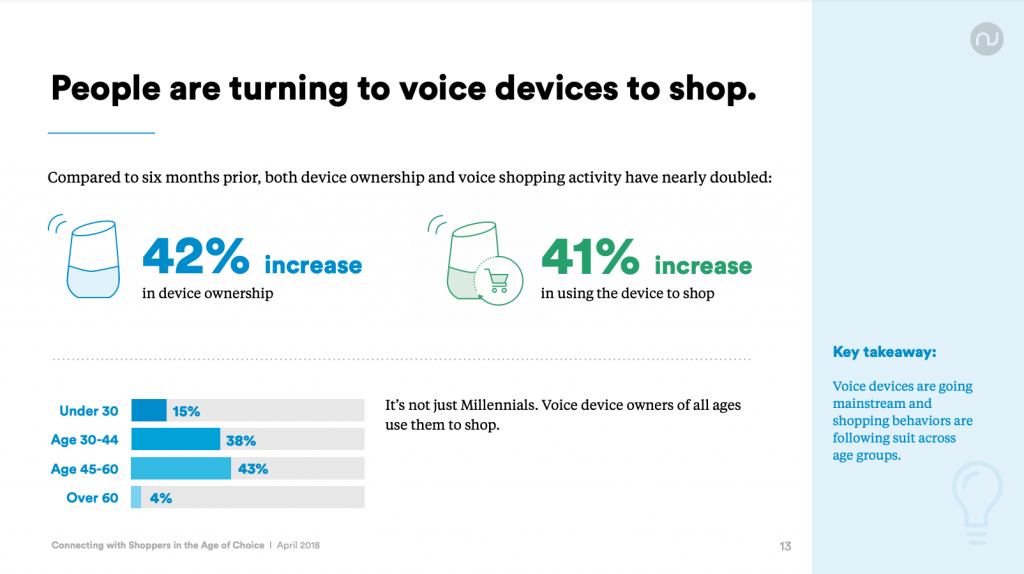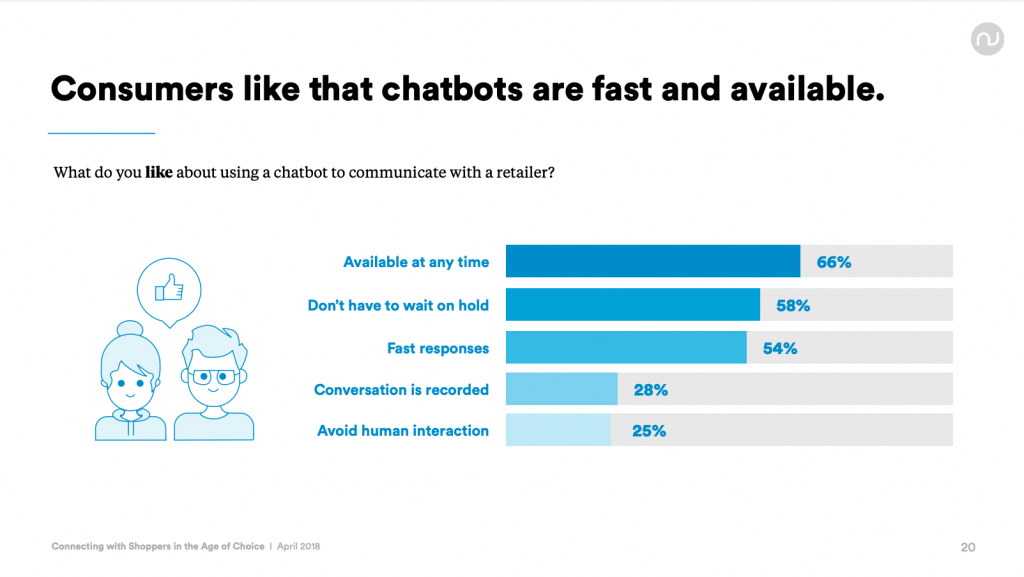7 E-commerce Trends to Set Your Sights on in 2021
Back to the Future is my all-time favorite movie. Why? For starters, they correctly predicted a number of technologies that exist today: personal drones, mobile payments, and smart clothing.
This article can’t predict the future of e-commerce however. But we don’t need to, because a lot of what we want to talk about is already happening!
Key trends indicating the future of e-commerce include voice shopping, visual search, connected devices to make purchases (via IoT, AR, VR), increased mobile commerce (m-commerce for those in the know!), the use of artificial intelligence, greater adoption of chatbots, and cryptocurrencies.
We’ve also made a list of actions that you can take today to help your e-commerce brand evolve before it’s too late to keep up with some of these trends.
Keep an open mind as you scope out practices to apply to your business, and remember: although some of these may seem overwhelming, amazing technologies (like VIV’s e-commerce solution) exist to help make the process easier for non-developer e-commerce merchants to jump on the bandwagon. So read on, and get ready to jump.
Trend 1. Voice Shopping
Voice Shopping is simple really: it consists of you using your voice to make a purchase—using voice assistant technology included in smartphones, or voice-activated devices such as Amazon Echo, or Google Home.
According to the Voicebot Smart Speaker Consumer Adoption Report, 26% of consumers are already using a voice-activated virtual assistant to make online purchases, as of 2018. This number will continue to increase over time with wider user adoption.

Navar Company says the voice shopping is trending
Voice-activated devices can remember purchases, remind shoppers to reorder items, track orders, apply coupons and discounts, and recommend brands and products based on reviews posted by Amazon customers.
Voice-activated devices are only getting smarter and improving, notably with regards to semantic search. It allows search engines to consider the intent and contextual meaning of search phrases when generating search results.
If you would like for your e-commerce store to benefit from the voice shopping business boom, you can connect your online store to Amazon using VIV’s e-commerce solution.
Trend 2. Visual Search: AR / VR
Visual search can be carried out through a number of means such as reverse image searches, augmented reality, or virtual reality using a variety of devices (like smartphones, glasses, or specially made goggles).
Augmented Reality is an interactive experience with a device (like a phone or AR glasses) to identify objects, places, and languages. AR can visually annotate our everyday lives with more information and heightened experience, sometimes using multiple stimulus modalities like visual, auditory, haptic, and olfactory senses—even all at once.
According to Oxford Languages, Virtual Reality is a “computer-generated simulation of a three-dimensional image or environment that can be interacted with in a seemingly real or physical way by a person using special electronic equipment, such as a helmet with a screen inside or gloves fitted with sensors”.
Google is already testing these technologies with YouTube AR Try-on, and Google Lens.

Ikea is providing AR technology via their Ikea Place app allowing customers to see what their
furniture would look like in their home before ordering it
If you’d like to benefit from the power of visual search, you can connect your online store to Instagram Shopping and to your Facebook Business Page to be able to tag products in photos and stories.
Trend 3. IoT: Internet of Things
The Internet of Things (IoT) is also expanding and is currently playing an important role in the transformation of Brick-and-Mortar retail.
You may have already seen electronic shelf labels that improve inventory management, reduce overhead, and optimize price changes in physical stores.
But what does the Internet of Things even mean? Simply put, this is the concept of connecting any device to the Internet — from smartphones and wearables to household appliances.
Take a smart fridge as an example. It allows customers to automatically place one-time or recurring orders when certain food items are low, using Amazon’s Alexa virtual assistant technology.
Trend 4. M-Commerce
50% of site traffic comes from mobile devices, and that number will continue to grow. In fact, over 50% of online sales are expected to be from mobile devices in 2021.

Statista is predicting the mobile shopping will continue growing in 2021
Given these statistics, it’s shocking to see that many merchants don’t yet have a mobile responsive site! If your site isn’t mobile-friendly yet, you’re missing out on up to 50% of potential sales. So do yourself and your shop a favor, and ensure your site is user-friendly on mobile.
Trend 5. AI: Artificial intelligence
Artificial Intelligence (AI) consists of human-like intelligence in machines and devices that are programmed to learn, adapt, improve, and solve real-life problems. Artificial Intelligence applies machine learning, deep learning, and other techniques to solve complex problems.
In e-commerce, AI can be used for marketing and conversion optimization, inventory management and replenishment optimization, personalized shopping, and advanced automations.
Trend 6. Chatbots
Chatbots are becoming an essential part of the customer service experience and come with a number of benefits to consumers and merchants alike. They offer merchants a way to provide 24/7 customer support and automate replies to recurring questions, reducing overhead.
Customers benefit from quick response times, personalized answers to their questions, and frustration-free (or at least, frustration-minimized) shopping.

Customers admit they like chatbots for availability and speed
Chatbots can also be used to provide clients with product details, cross-sales, promotions, information on their order status, shipping, and more. Consumers are embracing chatbots as they become better at understanding commands and answering queries. Only 14% of consumers “do not like them at all” compared to 35% 6 months prior in a Navar study.
Trend 7. Crypto Payments
The use of Cryptocurrency Payments is on the rise, and adoption is growing, especially in emerging economies. Some of the most popular cryptocurrencies include Bitcoin, LiteCoin, and Etherium.

Source:
Coindesk
Keep an open mind about these new payment methods. We believe they will become more in demand for e-commerce in the near future.
What Can You Do About The Tomorrow of E-commerce—Today?
VIV’s e-commerce might be the best e-commerce solution for staying on top of new and emerging e-commerce trends. If you are not a developer, but you own a small- or medium-sized business and want to implement some powerful and trendy features in your online store, check us out!
VIV has an omnichannel e-commerce solution that is mobile responsive by default and can help you grow your store faster with Google Ads that are auto-optimized based on AI.
VIV’s e-commerce solution connects to advanced chatbot technologies and is compatible with a number of Crypto payment gateways. At VIV, we’re building for the future of e-commerce and is continually updated by a future-forward team. In the meantime, keep one eye on the trend horizon as you build your business empire, and feel free to share your success with any of these trends in the comments below.

We're Helping Local Businesses Succeed. Let’s grow together.
Get in touch today!
Let us know about your marketing goals and one of our marketing specialists will be in contact with you!
Browse Our Packages
We've been lucky to work with over 2,100+ businesses. Check out some of our packages!
CONTACT US
We bring the team to the table to provide the best value for your business strategy. We're experts at collaborating the many different moving parts of digital marketing so that you can be the expert at running your business.
(812) 618-9498
10999 Stahl Rd, Newburgh, IN 47630
USEFUL LINKS
All Rights Reserved | VIV
Evolv, Inc, doing business as Evolv is a registered Independent Sales Organization of Wells Fargo Bank N.A., Concord, CA and Fifth Third Bank, N.A., Cincinnati, OH


